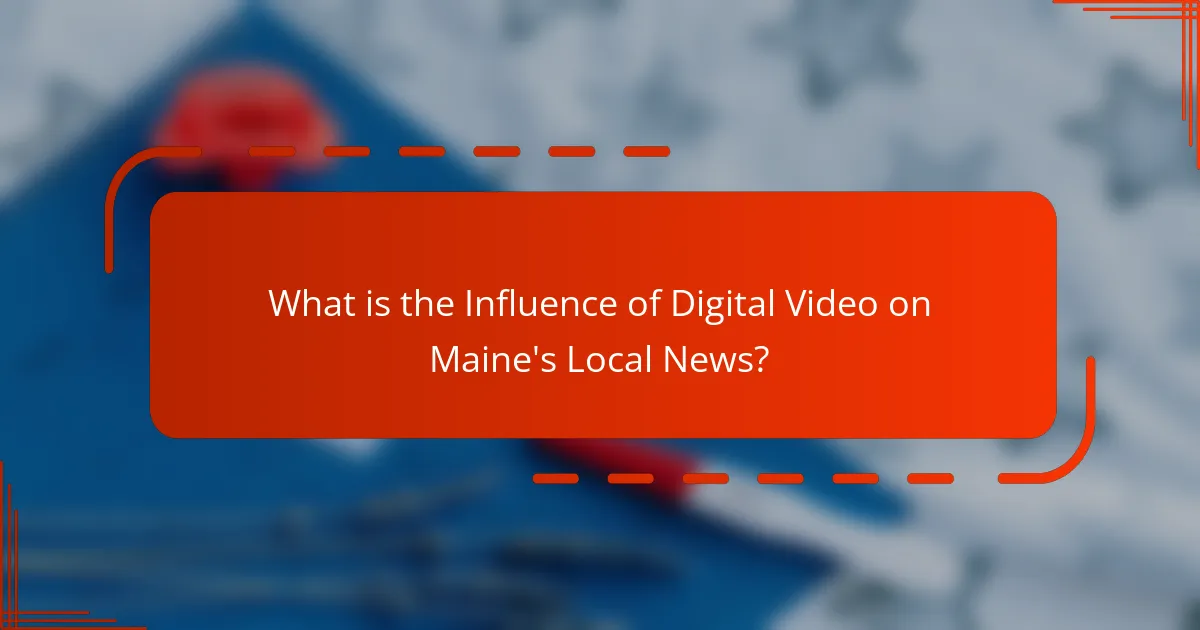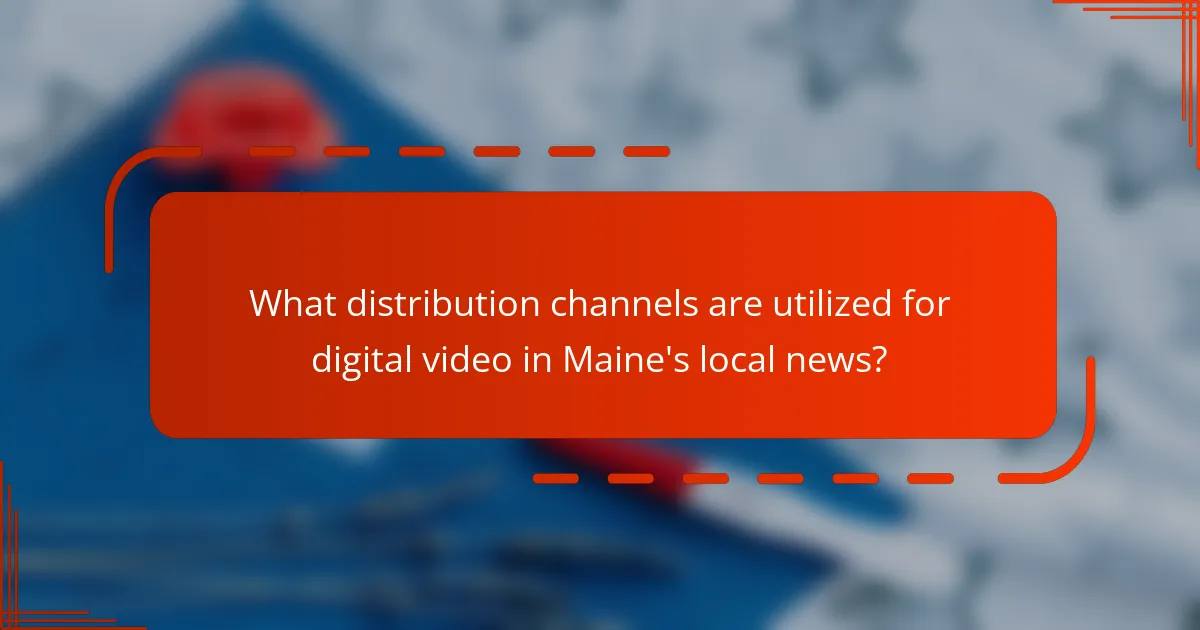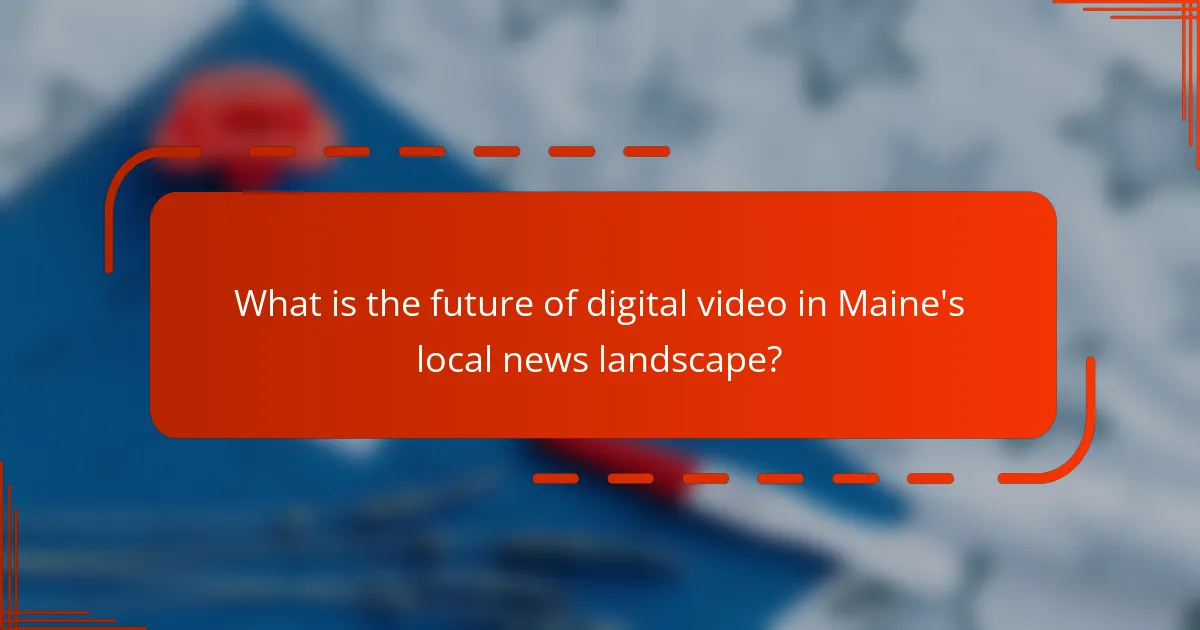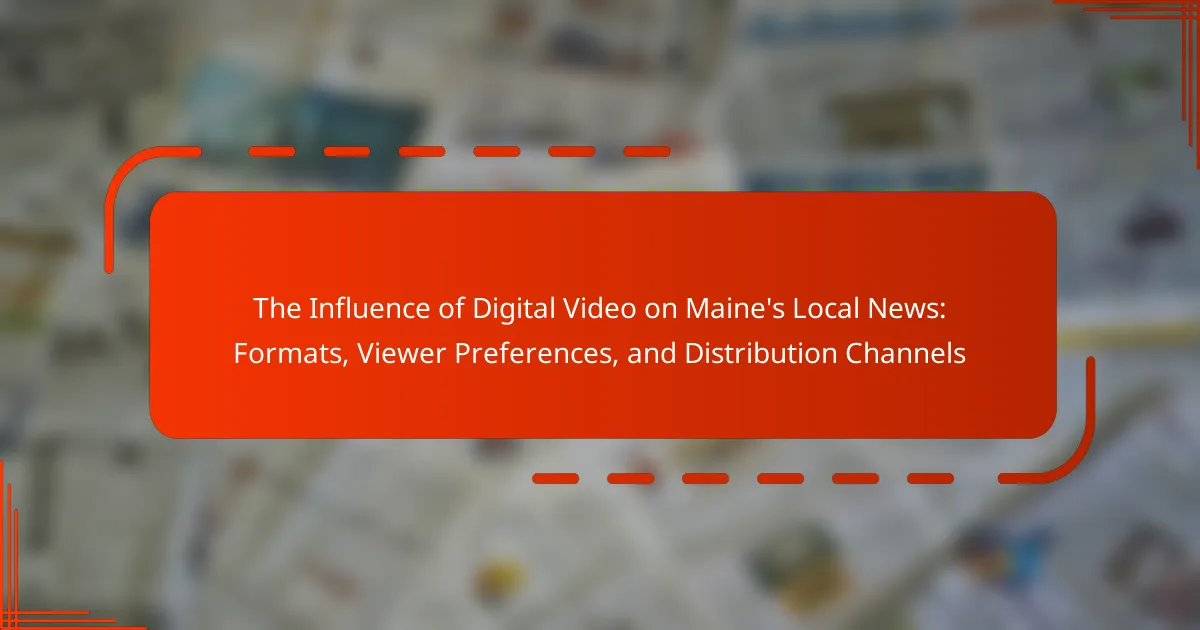Digital video is transforming Maine’s local news landscape by enhancing viewer engagement and adapting to changing audience preferences. With 57% of adults in Maine consuming news through digital platforms, local news outlets are increasingly utilizing short, shareable video formats across various distribution channels, including websites, social media, and streaming services. This shift not only allows for real-time reporting but also caters to the demand for on-demand and mobile content, as over 70% of residents prefer video news. As technology advances and production quality improves, local news organizations are investing in video production skills, indicating a promising future for digital video in Maine’s news delivery.

What is the Influence of Digital Video on Maine’s Local News?
Digital video significantly influences Maine’s local news landscape. It enhances viewer engagement through visually appealing content. Local news outlets are increasingly adopting digital video to attract younger audiences. According to a Pew Research study, 57% of adults in Maine consume news via digital platforms. This shift has led to changes in news delivery formats, prioritizing short, shareable videos. Additionally, digital video allows for real-time reporting and updates, increasing the timeliness of news coverage. The accessibility of video content on social media platforms further amplifies its reach. Consequently, traditional news formats are being adapted to meet the demands of digital consumption.
How has digital video transformed local news in Maine?
Digital video has significantly transformed local news in Maine by enhancing viewer engagement and accessibility. Local news outlets in Maine have adopted digital video to provide timely and relevant content. This shift allows for real-time reporting on local events, which is crucial for community engagement. The incorporation of video has also led to increased viewership on digital platforms. Statistics show that video content can lead to higher retention rates among viewers. Additionally, local news stations have expanded their reach through social media platforms, where video content is more likely to be shared. This transformation reflects a broader trend in media consumption, where audiences prefer visual storytelling. Overall, digital video has made local news in Maine more dynamic and responsive to community needs.
What are the key features of digital video in news reporting?
Key features of digital video in news reporting include immediacy, interactivity, and accessibility. Immediacy allows news organizations to deliver content quickly. This is crucial during breaking news events. Interactivity enables viewers to engage with the content through comments and shares. This engagement can enhance viewer loyalty and community connection. Accessibility ensures that videos are available across multiple platforms. This includes mobile devices, social media, and websites. Furthermore, high-definition quality enhances viewer experience, making content more appealing. Analytics tools provide insights into viewer behavior, helping news organizations tailor their content. These features collectively transform how news is consumed and shared.
How does digital video enhance storytelling in local news?
Digital video enhances storytelling in local news by providing visual engagement and emotional connection. It allows viewers to see events as they unfold, creating a sense of immediacy. This medium captures nuances that text alone cannot convey, such as tone and body language. According to a 2021 Pew Research study, 86% of local news consumers prefer video content over written articles. Digital video also facilitates storytelling through diverse formats, including live coverage and short clips. These formats cater to varying viewer preferences, increasing audience retention. Furthermore, analytics show that video stories receive higher shares on social media, expanding reach. Thus, digital video is a crucial tool in modern local news storytelling.
What formats of digital video are commonly used in Maine’s local news?
Common formats of digital video used in Maine’s local news include live streaming, short clips, and full-length reports. Live streaming allows real-time broadcasting of news events. Short clips are typically used for quick updates or highlights. Full-length reports provide in-depth coverage of news stories. These formats cater to diverse viewer preferences. The integration of these formats enhances audience engagement. Additionally, local news outlets often utilize social media platforms for distribution. This approach maximizes reach and accessibility for viewers across Maine.
What are the most popular types of digital video formats?
The most popular types of digital video formats include MP4, AVI, MOV, and MKV. MP4 is widely used for its compatibility across devices and platforms. AVI offers high quality but larger file sizes. MOV, developed by Apple, is favored for video editing. MKV supports various codecs and is popular for high-definition content. These formats are commonly utilized in streaming, sharing, and editing video content. Their popularity is backed by their versatility and user-friendly features.
How do different formats cater to various audience preferences?
Different formats cater to various audience preferences by providing diverse ways to consume content. For instance, video formats appeal to visual learners and those seeking engaging storytelling. Text formats, such as articles, serve audiences who prefer in-depth analysis and detailed information. Audio formats, like podcasts, attract listeners who multitask or enjoy auditory learning. Research indicates that 80% of consumers prefer video content over text. This preference is driven by the ability of video to convey emotions and complex narratives effectively. Additionally, short-form content is favored by audiences with limited attention spans, while long-form content attracts those seeking comprehensive insights. Therefore, offering multiple formats allows media outlets to reach broader demographics and enhance user engagement.
What are viewer preferences regarding digital video in local news?
Viewer preferences regarding digital video in local news emphasize brevity and relevance. Research indicates that viewers favor short video segments, ideally under two minutes. They prefer content that is informative and directly related to local issues. High-quality visuals and professional presentation are also important to viewers. A survey by the Pew Research Center found that 78% of local news consumers value video content that provides updates on local events. Additionally, viewers enjoy interactive elements, such as polls and comment sections, enhancing engagement. Overall, viewer preferences highlight a demand for concise, relevant, and engaging digital video content in local news.
What demographics are most engaged with digital video content?
Young adults aged 18 to 34 are the most engaged demographic with digital video content. This group actively consumes video across various platforms, including social media and streaming services. According to a 2021 report by Statista, 90% of individuals in this age range watch digital videos monthly. Additionally, the 35 to 54 age group also shows significant engagement, with 75% consuming video content regularly. These statistics illustrate a clear trend of higher engagement among younger audiences, indicating their preference for digital video over traditional media formats.
How do viewer preferences impact content creation in local news?
Viewer preferences significantly influence content creation in local news. Local news outlets analyze viewer demographics and interests to tailor their content. This ensures higher engagement and viewership. For instance, if viewers prefer human-interest stories, local news will prioritize such content. Research indicates that 70% of local news consumers favor stories that reflect their community. Additionally, feedback from social media platforms shapes the types of stories covered. Local news organizations often adjust their reporting style based on viewer feedback. This adaptability helps maintain relevance in a competitive media landscape.

What distribution channels are utilized for digital video in Maine’s local news?
Maine’s local news utilizes various distribution channels for digital video. These channels include websites of local news stations, social media platforms, and streaming services. Local news stations often post videos on their official websites for easy access. Social media platforms like Facebook and Twitter are popular for sharing video clips. Streaming services such as YouTube also host content from local news outlets. Additionally, mobile apps from news organizations provide direct access to digital video content. These channels enhance viewer engagement and accessibility to local news stories.
How do local news outlets distribute digital video content?
Local news outlets distribute digital video content primarily through their websites and social media platforms. They upload videos to their own sites to attract viewers and provide on-demand access. Social media channels like Facebook, Twitter, and Instagram serve as additional distribution points. These platforms allow for wider reach and engagement with audiences. Many outlets also use video-sharing sites like YouTube to expand visibility. Email newsletters often include links to video content to drive traffic. Additionally, some local news stations offer mobile apps for direct access to video updates. This multi-channel approach maximizes audience engagement and enhances content accessibility.
What platforms are most effective for reaching viewers?
Social media platforms are most effective for reaching viewers. Platforms like Facebook, Instagram, and Twitter have large user bases. They allow for targeted advertising and engagement. Video content on these platforms often receives higher interaction rates. According to a report by Pew Research Center, 69% of adults use Facebook. YouTube also ranks highly as a video-sharing platform. It has over 2 billion logged-in monthly users. These platforms facilitate sharing, which increases visibility. Overall, social media and video platforms are crucial for effective viewer outreach.
How does social media influence the distribution of local news videos?
Social media significantly influences the distribution of local news videos by providing immediate access to content. Platforms like Facebook and Twitter allow news organizations to share videos instantly with a broad audience. This immediacy increases viewer engagement and encourages sharing among users. According to a Pew Research Center study, 62% of adults get news from social media. This statistic highlights the importance of these platforms for reaching local audiences. Additionally, social media algorithms prioritize engaging content, often promoting local news videos over traditional news outlets. As a result, local news organizations can leverage these platforms to enhance visibility and reach.
What challenges do local news stations face in digital video distribution?
Local news stations face several challenges in digital video distribution. One major challenge is competition from online platforms. Streaming services and social media outlets attract viewers away from traditional news sources. Limited resources also hinder local stations. They often lack the budget for high-quality production and distribution technology.
Additionally, audience engagement is a concern. Many viewers prefer short, engaging content, which local stations may struggle to produce. Adapting to changing viewer preferences requires constant innovation.
Moreover, monetization of digital content poses difficulties. Local news stations often rely on traditional advertising models that do not translate well to digital platforms. This can lead to reduced revenue streams.
Lastly, technological barriers can impede effective distribution. Not all local stations have access to advanced analytics tools to measure viewer engagement and optimize content accordingly. These factors collectively challenge local news stations in effectively distributing digital video.
What technological barriers affect video distribution?
Technological barriers affecting video distribution include bandwidth limitations, encoding issues, and compatibility problems. Bandwidth limitations restrict the speed at which video content can be transmitted. This can lead to buffering and reduced quality for viewers. Encoding issues arise when video files are not properly compressed for efficient delivery. This can result in longer loading times and compatibility problems across different devices and platforms. Compatibility issues occur when video formats are not supported by certain devices or browsers. This limits audience reach and engagement. Overall, these barriers can hinder the effective distribution of video content.
How do competition and audience fragmentation impact distribution strategies?
Competition and audience fragmentation significantly influence distribution strategies in local news. Increased competition leads to more diverse content offerings. This compels news organizations to adopt targeted distribution methods. Audience fragmentation results in varied viewer preferences across platforms. As a result, local news outlets must utilize multiple channels to reach segmented audiences. Data from the Pew Research Center indicates that 57% of Americans get news from social media. This statistic highlights the necessity for local news to integrate social media into their distribution strategies. Consequently, adapting to these dynamics is essential for maintaining audience engagement and relevance.

What is the future of digital video in Maine’s local news landscape?
The future of digital video in Maine’s local news landscape is expected to grow significantly. Local news outlets are increasingly adopting digital video formats. This shift is driven by changing viewer preferences for on-demand and mobile content. Research indicates that over 70% of Maine residents prefer consuming news through video. Enhanced distribution channels, such as social media platforms, are also expanding reach. As technology advances, production quality is likely to improve. Local news organizations are investing in training for video production skills. The combination of these factors suggests a robust future for digital video in Maine’s local news.
How is the landscape of local news evolving with digital video?
The landscape of local news is evolving rapidly due to digital video integration. Local news outlets are increasingly adopting video content to engage viewers. This shift is driven by changing viewer preferences for consuming news. Research indicates that 85% of consumers prefer video content over text. Digital video enhances storytelling by providing visual context and emotional appeal. Platforms like social media amplify the reach of local news videos. This evolution also necessitates new distribution channels, such as streaming services and mobile apps. As a result, local news organizations are adapting their strategies to remain relevant in a digital-first environment.
What trends are emerging in digital video usage among local news outlets?
Local news outlets are increasingly adopting short-form video content. This trend aligns with viewer preferences for quick, digestible news updates. Platforms like social media are driving this shift, as they favor shorter videos. Additionally, local news organizations are utilizing live streaming to engage audiences in real-time. This approach fosters immediacy and community interaction. Data shows that local viewers are more likely to engage with video content over text. Furthermore, there is a growing emphasis on mobile-friendly video formats. This adaptation caters to the rising number of users consuming news on smartphones. Overall, local news outlets are evolving their video strategies to meet changing viewer habits.
How might viewer preferences shift in the coming years?
Viewer preferences may shift towards more personalized and on-demand content. As technology advances, audiences increasingly favor tailored experiences. They are gravitating towards platforms that offer interactive features and user-generated content. Data from the Pew Research Center shows that 67% of users prefer video content over text. Additionally, younger demographics are more inclined to consume news via social media channels. This trend indicates a decline in traditional news formats. The rise of mobile devices also influences viewer habits, with 85% of users accessing news on smartphones. Overall, these factors suggest a significant transformation in how viewers engage with local news.
What best practices should local news stations follow for digital video?
Local news stations should prioritize high-quality production and engaging storytelling for digital video. Clear audio and sharp visuals enhance viewer experience. Shorter video lengths cater to online audiences’ attention spans. Incorporating captions improves accessibility and viewer retention. Consistent branding across videos fosters recognition and trust. Utilizing social media platforms for distribution increases reach and engagement. Analyzing viewer analytics helps tailor content to audience preferences. Regularly updating content keeps the audience informed and engaged.
How can local news outlets optimize their digital video content?
Local news outlets can optimize their digital video content by focusing on audience engagement and platform-specific strategies. They should analyze viewer preferences to tailor content accordingly. Incorporating interactive elements can enhance viewer participation. Using analytics tools helps track performance metrics effectively. Shorter videos often perform better, catering to audience attention spans. High-quality visuals and sound are essential for maintaining professionalism. Consistent posting schedules can build viewer loyalty. Collaborating with local influencers may expand reach.
What strategies can enhance viewer engagement with digital video?
Utilizing interactive elements can enhance viewer engagement with digital video. Incorporating polls, quizzes, and clickable links encourages active participation. Personalization of content based on viewer preferences increases relevance. Short, attention-grabbing formats keep viewers interested and reduce drop-off rates. Storytelling techniques create emotional connections, making content more relatable. Consistent posting schedules help build audience anticipation and loyalty. Analyzing viewer feedback allows for continuous improvement of content strategies. Research indicates that videos with interactive features can boost engagement rates by up to 80%.
The main entity of this article is digital video and its influence on local news in Maine. The article examines how digital video enhances viewer engagement, transforms storytelling, and adapts distribution channels in the local news landscape. Key topics include the various formats of digital video utilized, viewer preferences for content, and the challenges faced by local news stations in distribution. Additionally, it highlights emerging trends and best practices for optimizing digital video content to meet audience demands and improve engagement. Overall, the piece provides a comprehensive overview of the evolving dynamics of local news in the context of digital video.
